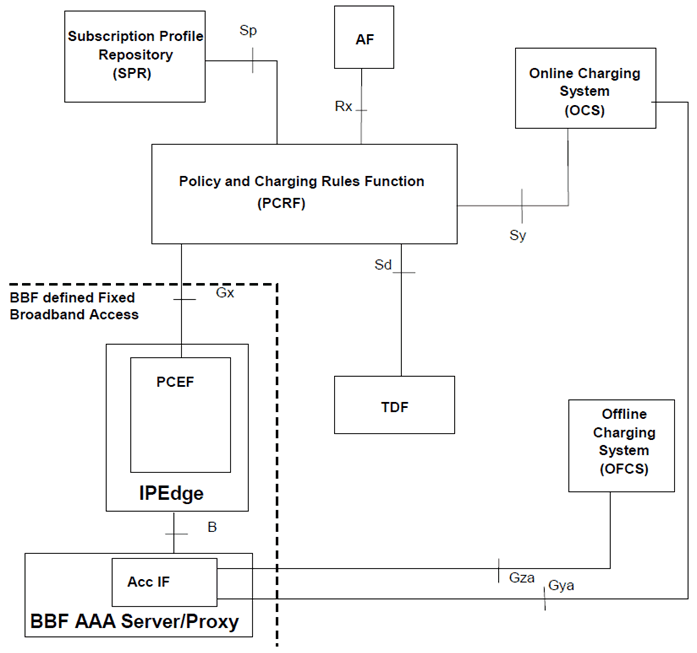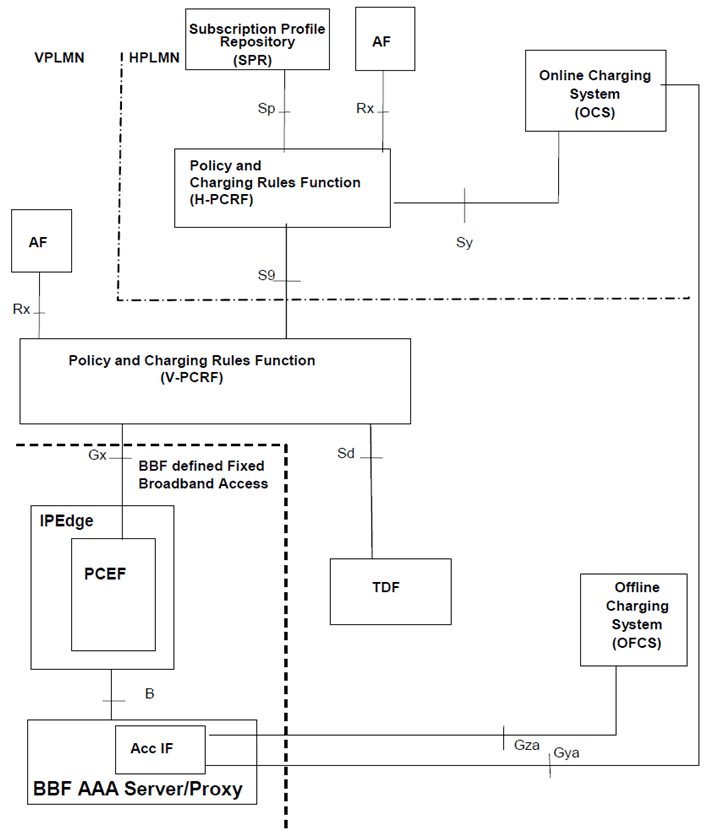Content for TS 23.203 Word version: 19.1.0
0…
4…
5…
6…
6.1.4…
6.1.7…
6.1.10…
6.1.17…
6.2…
6.2.2…
6.2.3…
6.3
6.4…
6.8…
7…
7.3…
7.4…
7.7…
7.7.3…
7.8…
A…
A.4…
D…
P…
P.4.2.4…
P.7…
P.7.5…
P.8
Q…
S…
S.7…
S.8.8
T…
S.7 PCC Procedures and Flows
S.7.1 Introduction
S.7.2 IP-CAN Session Establishment
S.7.3 IP-CAN Session Termination
S.7.4 IP-CAN Session Modification
S.7.5 Update of the subscription information in the PCRF
S.7.6 PCRF Discovery and selection
S.8 Charging using AAA signalling
S.8.1 Reference architecture - Non-Roaming
S.8.2 Reference architecture - Roaming
S.8.3 Gza Reference Point
S.8.4 Gya Reference Point
S.8.5 B Reference Point
S.8.6 AAA based charging
S.8.7 Accounting Interworking Function
...
...
S.7 PCC Procedures and Flows p. 253
S.7.1 Introduction p. 253
A "Fixed Broadband Access IP-CAN" is a fixed access broadband network that provides IP connectivity to a UE. The Fixed Broadband Access IP-CAN reuses the definition of an IP-CAN session in this specification.
The AF can provide the NATed IP address and ports used by the UE (for IMS, according to TS 23.228).
The Fixed Broadband Access network does not support the concept of a bearer and multiple bearers as defined in TS 23.401. However, DSCP marking provides QoS support on transport network layer so that QoS and charging policies can be applied per SDF.
Case 1, no Gateway Control Session applies for Fixed Broadband Access.
The procedures cover both non-roaming and roaming with access to NSWO APN for a 3GPP UE. For the roaming case with access to NSWO APN, the V-PCRF interacts with the IP-Edge PCEF and, if Sd applies, with the TDF.
S.7.2 IP-CAN Session Establishment p. 253
The PCEF located in the IP-Edge initiates the Gx IP-CAN Session establishment as defined in clause 7.2. The session is initiated after that the IP-Edge becomes aware of an IPv4 address and/or an IPv6 prefix has been assigned to the fixed device and/or 3GPP UE.
In route mode configuration with NATed RG, the session is initiated after the RG has been connected to the network and has been assigned an IPv4 address and/or IPv6 Prefix. The IPv4 address and/or IPv6 Prefix are assigned as per Broadband Forum specifications and it is out of scope of 3GPP.
In bridge mode, the session is initiated after the device has been authenticated has been assigned an IPv4 address and/or IPv6 address or IPv6 Prefix by the Fixed Broadband access.
Operator policies in the PCEF indicate if dynamic policy control is provided. In addition, the NSWO-APN is also configured for subscribers on a PLMN basis.
The PCEF located in the IP-Edge includes in the IP-CAN Session establishment message the Subscriber-Id, NSWO-APN if available, IP-CAN type, the Default QoS if available, the PLMN id if available and the location information as defined in clause S.6.1.1.1.
The IP-Edge maps the Default-Access-Profile QoS to Default-QoS as defined in clause S.5.5.1.
The PCRF may provision a Default QoS or a Default QoS profile, PCC Rules to activate and Events Triggers to report.
S.7.3 IP-CAN Session Termination p. 254
This procedure is in accordance with clause 7.3.2 with the exceptions listed in this Annex. The UE-initiated IP-CAN session termination is not to applicable to Fixed Broadband Access.
The IP-CAN session termination is triggered by PCEF when Subscriber IP session is terminated. The trigger to terminate the Subscriber IP session may be HSS/AAA request to detach the UE or may be Broadband Forum specific (e.g. RG switch off, loss of transmission, IP address lease expiration PPPoE session termination, etc) and out of the scope of 3GPP.
In routed mode configuration with NAT this procedure is applicable only when IP session from RG is terminated, e.g. when RG switches off or when public IP address assigned to the RG is released, etc.
S.7.4 IP-CAN Session Modification p. 254
S.7.4.1 PCEF-Initiated IP-CAN Session Modification p. 254
This clause is related to IP-CAN session modification initiated by IP-Edge/PCEF for IP session. This procedure is in accordance with clause 7.4.1 with the exceptions listed in this Annex.
In routed mode with NAT, this procedure can be triggered when new device connects to the RG, for example when UE requests a local IP address to the RG or when a UE disconnects from WLAN.
The IP-Edge reports that an Event was met, including the Event Trigger and the affected PCC Rule. If TDF applies, the PCRF may provide ADC Rules and Event Triggers to the TDF and may provide PCC Rule, Event Triggers and a Default QoS or a Default QoS profile to PCEF.
S.7.4.2 PCRF-Initiated IP-CAN Session Modification p. 254
This procedure is in accordance with clause 7.4.2 with the exceptions listed in this Annex.
The PCRF may also provide a Default QoS or a Default QoS profile to PCEF.
S.7.5 Update of the subscription information in the PCRF p. 254
This procedure is in accordance with clause 7.5 when the UE's (i.e. RG, fixed device or 3GPP UE) profile changes.
S.7.6 PCRF Discovery and selection p. 255
PCRF discovery and selection follows the principles defined in clause 7.6 with the following modification:
- The Subscriber ID specified in clause S.5.1.2 is used as user identity.
- For a 3GPP UE, the NSWO-APN is also available.
- The IPv6 address may be included in the IP-CAN session establishment in the case of bridge-mode RG.
S.8 Charging using AAA signalling |R13| p. 255
The architecture shall provide charging for traffic exchanged by fixed devices and NSWO traffic to/from 3GPP UEs using AAA signalling.
In this release in case of AAA-based charging the BBF AAA server is used for performing accounting of fixed device as defined by BBF specifications TR-101 [35] and TR-146 [36].
For the charging session over Gya and Gza, the user identifier is the same that is issued over the Gx session
S.8.1 Reference architecture - Non-Roaming p. 256

Figure S.8.1: PCC Reference architecture for Fixed Broadband Access convergence when AAA-based accounting is used
(⇒ copy of original 3GPP image)
(⇒ copy of original 3GPP image)
S.8.2 Reference architecture - Roaming p. 257

Figure S.8.2: PCC Reference architecture for Fixed Broadband Access convergence (roaming) when AAA-based accounting is used
(⇒ copy of original 3GPP image)
(⇒ copy of original 3GPP image)
S.8.3 Gza Reference Point p. 257
To transport charging information about 3GPP UE, the Gza reference point is located between Accounting Interworking function in the BBF defined network and the 3GPP offline charging system OFCS located in the VPLMN (roaming scenario) or in the HPLMN (non-roaming scenario).
To transport charging information about fixed devices, the Gza reference point is located between the Accounting Interworking function in the BBF defined network and the 3GPP offline charging system located in the HPLMN (only non-roaming scenario).
S.8.4 Gya Reference Point p. 258
The Gya reference point is located between the Accounting Interworking function in the BBF defined Access Network and the 3GPP online charging system OCS located in the HPLMN and it transports charging information for 3GPP UE.
The Gya reference point is located between the Accounting Interworking function in the BBF defined Access Network and the 3GPP online charging system located in the HPLMN and it transports charging information for fixed device.
S.8.5 B Reference Point p. 258
This reference point is defined in BBF TR-300 [37].
S.8.6 AAA based charging p. 258
The charging support for NSWO traffic for 3GPP UE and fixed devices can be provided when the BBF network reports per-user accounting data via B and Gya/Gza reference points.
Offline and online charging may be supported by the 3GPP and BBF domain. In this Release, in case of AAA-based charging, the Online charging is supported based on existing capability supported by B reference point and IP-Edge with limitation based on AAA RADIUS/Diameter accounting in the BBF network (e.g. BNG capability, usage of RADIUS over B reference point).
For RG in routed mode configuration with NAT, the single devices (i.e. fixed device and 3GPP UE) connected behind a RG can not be recognised, so the accounting is performed only for the RG.
In case of RG bridge mode configuration and in routed mode configuration without NAT the AAA based charging is performed per single devices having a Subscriber IP session.
In order to allow performing charging for fixed devices, the following assumptions are made about functionality in the Fixed Broadband Network:
- The BBF network is able to collect per user accounting data for fixed devices and periodically report this data via the B reference point.
S.8.7 Accounting Interworking Function p. 258
The Accounting Interworking Function that performs translation of the accounting signalling and parameters that are understood by the IP-Edge into the credit management signalling and parameters that are understood by the OCS and the OFCS is defined in BBF TR-300 [37].